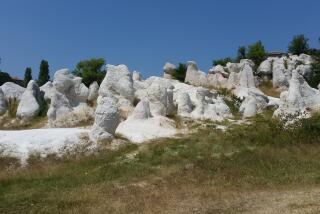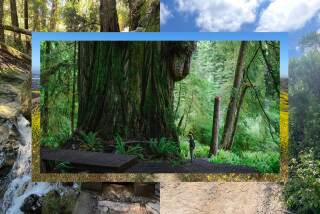Role-Playing Stones : Movies: Hollywood has come calling again on Vasquez Rocks. They will be the backdrop for “The Flintstones” film.
- Share via
Like some modern-day caveman, Jason Lems adjusts his sunglasses and motions toward the Vasquez Rocks--twisted, angry stone formations that have been the Santa Clarita Valley’s loneliest landmarks for 20 million years.
“There,” says the 21-year-old park ranger, pointing toward a half-finished structure the color of cartoon orange. “That’s Fred’s house. Barney’s going to live right next door.”
He’s talking, of course, about Fred Flintstone and his pint-size pal, Barney Rubble. Hurried workers were laying the huge slabs of prehistoric slate that serve as roofs in the community of Bedrock, where Fred and Barney live.
But it’s 1993. (That’s AD folks, not BC). This is a movie set--a modern Stone Age fantasy. Those funky homes are actually shaped from sculpted foam. And that big brontosaurus bone? Pure plaster of Paris, man.
Just as it has for generations, Hollywood once again has come calling on the Vasquez Rocks--the clutch of oddball cliffs that has served as the backdrop for thousands of films, TV shows, photo shoots and commercials.
In all, more than 200 projects are shot at the rocks each year--ranking them as the most commercially photographed boulders on the planet.
Over the years, the Vasquez Rocks have starred as the lunar surface and planets in galaxies far, far away. They’ve played the Old West, the snowcapped Swiss Alps, the Sahara Desert, scenic Mexico, the Grand Canyon, the Big Sky badlands and that sad, soulless outpost known as The Middle of Nowhere.
They’re the Southern California version of Australia’s Ayers Rock. The Hollywood Outback. Just west of East Jesus. The Back of Beyond.
Since the first silent film was shot here in 1905, the rocks have played opposite some lofty company. John Wayne once filmed here, along with Errol Flynn, Buck Rogers, Natalie Wood, Gary Cooper, Cary Grant and Jimmy Stewart.
So did the Lone Ranger. Cisco and Pancho. Spock and Captain Kirk. Little Joe and Victoria Barkley. The Village People. Raquel Welch. Bill and Ted even had their Bogus Adventure here.
For rocks, their film credits read like a page from TV Guide: “The Charge of the Light Brigade,” “Gunga Din,” “Star Trek,” “Battlestar Galactica,” “Rich Man, Poor Man.” The Cartwrights once galloped around the Vasquez Rocks in the old “Bonanza” television series. So did the boys from “The Big Valley.”
Angela Lansbury has taped episodes of “Murder She Wrote.” The Marine Corps shot its medieval chessboard commercial here as well. And Taco Bell has returned time and again for its “Run for the Border” ads.
So has the Energizer battery bunny. As well as Hanes underwear. Playboy and Muscle magazines. MasterCard. Wrigley’s gum. Michael Jackson shot part of his “Black and White” video here. Mark Harmon has pitched Coors beer at a campfire lit at the rocks. And perched on a boom crane, Bob Hope has cracked one-liners for Texaco.
And now, Steven Spielberg is taking his turn. This month he plans to start shooting “The Flintstones,” starring John Goodman as fat Freddy. Filmmakers say the prehistoric pallor makes the rocks a perfect setting for the town of Bedrock.
“It’s this terrifically stark, exciting visual landscape that just naturally lends itself to become Fred’s street, the cul-de-sac of the Flintstones,” says William Sandell, production designer for the film.
“Because the movie takes place in a world full of upheaval, one that isn’t smooth. It’s in flux. The terrain is yellowy, bubbling volcanoes, an unsettled Earth. And without uttering a word, the Vasquez Rocks say that perfectly.”
Rocks, of course, don’t talk. But out at Vasquez Rocks County Park, there’s a staff of rangers--spokesmen, if you will--that do their talking for them. The rangers make sure that none of the Hollywood film crews damage the 745-acre park’s timeless, fragile landscape.
Despite the exclusive atmosphere of most movie shoots, the rangers also see that the filming doesn’t interfere with the public’s use of the park--located near Agua Dulce, just off the Antelope Valley Freeway.
More than 5,000 people visit the rocks each month, including busloads of Japanese tourists. Some merely picnic and take in the view. Others explore the network of paths that intertwine the formations. Or they rappel off the craggy stone faces that erupt out of the ground at absurd angles.
Others go berserk, running up and down the rocks, acting like screaming lunatics marooned on a faraway planet in some episode of the “Twilight Zone,” with a deadpan Rod Serling smoking a cigarette nearby.
Still, the rocks pose their danger. Rattlesnakes thrive there. And last summer a teen-age girl died after tumbling from the largest cliff.
“But whatever they do, the public has first option--after all, this is their park,” says ranger Sandy Dininger. “We can’t let producers start pushing people around, ordering them off their set. We put a stop to that.”
The Vasquez Rocks have nonetheless proven to be a filmmaker’s bargain basement. Located within the contracted 30-mile radius of Hollywood, movie companies don’t have to pay actors and crews out-of-town rates for shoots there.
Production rates charged by the county for use of the rocks are also extremely low--$400 daily for filming and $100 for each preparatory day--a bargain compared to similar natural sites in Arizona or Northern California.
“We still get complaints that our rates are too high,” says Frank Hovore, natural areas administrator for the Los Angeles County Parks and Recreation Department, which collects $30,000 annually from such commercial uses.
“These people don’t realize that the rocks are stars in their films as much as any actor. They set the stage, create the backdrop. And these rocks provide a different profile from every angle you shoot from.
“On location, they deserve a dressing room of their own.”
*
If the Vasquez Rocks have played host to some colorful film characters, few could match the drama of their own namesake--the rough and ready Tiburcio Vasquez.
Born in Monterey, Calif., in 1835, a young Vasquez and two accomplices--including famed bandit Anastasio Garcia--stabbed to death a local constable during a brawl in a fandango house.
Vasquez soon became one of California’s notorious bandidos, a folk hero with a sizable public following among Mexicans despite his cattle-rustling, stagecoach-robbing and womanizing habits.
He spent much of the late 1850s and 1860s behind bars in San Quentin and once escaped from that prison. By the time he was captured in May, 1874, Vasquez had become--next to Joaquin Murrieta--America’s most legendary Mexican outlaw.
Before Vasquez was hanged for murder in 1875 he had become a romantic figure, and women brought flowers to his jail cells in Los Angeles and San Jose, according to John Boessenecker, an author of two books on California outlaws, including “Badge and Buckshot: Lawlessness in Old California.”
During his years on the lam, Vasquez and his band supposedly held out in the desolate, arid sandstone rock formations around Agua Dulce, giving the rocks their informal name, said Boessenecker, who is writing a biography of Vasquez.
When the county began operating the park in the 1950s, Vasquez was officially immortalized by becoming perhaps the first Old West badman to have a park named after him.
More than 100 years after his capture, however, the name Vasquez is still stirring up trouble in these parts. Officials recently voted to name a proposed new high school Vasquez High, touching off a controversy over the killer’s past.
The rocks are shrouded in more mystique--namely, how they were formed. Twenty-two million years ago, geologists say, they sat on the floor of a prehistoric ocean.
In the ensuing eons, after the salt waters receded, violent floods washed away the softer formations around the rocks, revealing their weathered character.
Later, scientists theorize, earthquakes jolted the rocks, tilting them at obtuse, 50-degree angles--creating a nether world of pointy peaks that cast eerie shadows and change color as day dies.
“They’re an amazing thing to behold,” says UCLA geologist Walter Reed. “It’s like looking at L’Arc de Triomphe. Only these things are natural.”
Few, however, can agree on the images evoked by the formations, especially the largest, known only as “The Rock.” At certain angles, some say, they look like sperm whales surfacing from the ocean depths.
Or a sinking ship. A huge saddle. A set of bad teeth--very bad teeth. Or gnarled stones thrown haphazardly into the sand by an angry child.
“The one I just can’t fathom is how people say they look like frogs,” says park ranger Lems. “Every day, I look. And I still can’t see any frogs.”
For years, though, the dominant image at the rocks has been cowboys.
“Part of just about every American western made during the 1940s and ‘50s was shot at the Vasquez Rocks,” Hovore says. “Especially when they needed secondary shots of cattle drives and horses galloping across the plains.”
From “Flash Gordon” to “Star Trek,” science fiction thrillers used the rocks to represent everything from unnamed asteroids to the Planet Vulcan. “Every time Kirk and Spock went outside, it was the Vasquez Rocks in the background--no matter what planet they were supposedly on,” he says.
Several years ago, a movie spoof was made of such repetitive filming. In the hilarious “Amazon Women on the Moon,” characters ran back and forth on the same 50 feet of rock that was supposed to represent the entire planet.
“The thing is, the rocks look good in every role,” Reynolds says. “It’s believable that Capt. Kirk would beam down there from the Starship Enterprise or that Jack Palance would gun people down with a six-shooter. It all just sort of fits.”
But while Hollywood has yet to damage the site, Lems says the rocks still need a chaperon when producers come calling: “You have to watch these Hollywood types.”
Once, he says, during the filming of some B-grade movie, a group of models on the set surrounded him, groping his biceps and asking questions.
“All these beautiful women wanting my attention--I knew there was something wrong with that scene,” Lems recalls. “Meanwhile, the director was filming nude shots behind my back--and that’s definitely against the rules.”
Ranger Dininger often catches Vasquez Rocks featured on late-night movies. But there’s one wacky scene that will never make the tube.
During filming of “For the Boys” with Bette Midler, 500 extras dressed in heavy wool clothing were called to the rocks to shoot a scene set in winter. Trouble was, it was the middle of summer--when temperatures reach 115 degrees.
“And so, here are all these uncomfortably overdressed people, crouching around the rocks, waiting for lunch call,” she recalls. “The day before, they had been served meatloaf, while the stars got shark.
“Suddenly, one guy stands up and yells, ‘No more meatloaf!’ Pretty soon all 500 of them are chanting, their voices echoing through the rocks, ‘No more meatloaf! No more meatloaf!
“It was the strangest thing I ever saw.”
More to Read
Only good movies
Get the Indie Focus newsletter, Mark Olsen's weekly guide to the world of cinema.
You may occasionally receive promotional content from the Los Angeles Times.











